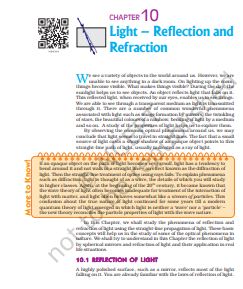‘NCERT Solutions for Class 10 Science Chapter 10‘ PDF Quick download link is given at the bottom of this article. You can see the PDF demo, size of the PDF, page numbers, and direct download Free PDF of ‘Ncert Class 10 Science Chapter 10 Exercise Solution’ using the download button.
NCERT Class 10 Science Textbook Chapter 10 With Answer PDF Free Download

Chapter 10: How do Organisms Reproduce
We see a variety of objects in the world around us. However, we are unable to see anything in a dark room.
On lighting up the room, things become visible. What makes things visible? During the day, the sunlight helps us to see objects. An object reflects light that falls on it.
This reflected light, when received by our eyes, enables us to see things. We are able to see through a transparent medium as light is transmitted through it.
There are a number of common wonderful phenomena associated with light such as image formation by mirrors, the twinkling of stars, the beautiful colors of a rainbow, the bending of light by a medium, and so on.
A study of the properties of light helps us to explore them. By observing the common optical phenomena around us, we may conclude that light seems to travel in straight lines.
The fact that a small source of light casts a sharp shadow of an opaque object pointing to this straight-line path of light, is usually indicated as a ray of light.
In this chapter, we shall study the phenomena of reflection and refraction of light using the straight-line propagation of light.
These basic concepts will help us in the study of some of the optical phenomena in nature. We shall try to understand in this Chapter the reflection of light by spherical mirrors and refraction of light and their application in real-life situations.
Let us recall these laws –
(i) The angle of incidence is equal to the angle of reflection, and
(ii) The incident ray, the normal to the mirror at the point of incidence, and the reflected ray, all lie in the same plane.
These laws of reflection are applicable to all types of reflecting surfaces including spherical surfaces.
You are familiar with the formation of an image by a plane mirror. What are the properties of the image?
The image formed by a plane mirror is always virtual and erect. The size of the image is equal to that of the object.
The image formed is as far behind the mirror as the object is in front of it. Further, the image is laterally inverted. How would the images be when the reflecting surfaces are curved? Let us explore.
The curved surface of a shining spoon could be considered a curved mirror. The most commonly used type of curved mirror is the spherical mirror.
The reflecting surface of such mirrors can be considered to form a part of the surface of a sphere. Such mirrors, whose reflecting surfaces are spherical, are called spherical mirrors. We shall now study spherical mirrors in some detail.
10.2 Spherical Mirrors
The reflecting surface of a spherical mirror may be curved inwards or outwards.
A spherical mirror, whose reflecting surface is curved inwards, that is, faces towards the center of the sphere, is called a concave mirror.
A spherical mirror whose reflecting surface is curved outwards, is called a convex mirror. The schematic representation of these mirrors is shown in Fig. 10.1. You may note in these diagrams that the back of the mirror is shaded.
| Author | NCERT |
| Language | English |
| No. of Pages | 27 |
| PDF Size | 3.8 MB |
| Category | Science |
| Source/Credits | ncert.nic.in |
NCERT Solutions Class 10 Science Chapter 10 Light Reflection and Refraction
1. Define the principal focus of a concave mirror.
Answer-
Light rays that are parallel to the principal axis of a concave mirror converge at a specific point on its principal axis after reflecting from the mirror. This point is called the principal focus of the concave mirror.
2. The radius of curvature of a spherical mirror is 20 cm. What is its focal length?
Answer-
Radius of curvature (R) = 20 cm
Radius of curvature of the spherical mirror = 2 × Focal length (f)
R = 2f
f= R/2 = 20 / 2 = 10
Therefore, the focal length of the spherical mirror is 10 cm.
3. Name the mirror that can give an erect and enlarged image of an object.
Answer-
The mirror that can give an erect and enlarged image of an object is the Concave Mirror.
4. Why do we prefer a convex mirror as a rear-view mirror in vehicles?
Answer-
A convex mirror is preferred as a rear-view mirror in cars and vehicles as it gives a wider field of view, which helps the driver to see most of the traffic behind him. Convex mirrors always form an erect, virtual, and diminished image of the objects placed in front of it.
How do Light Reflection and Refraction NCERT Textbook With Solutions PDF Free Download
